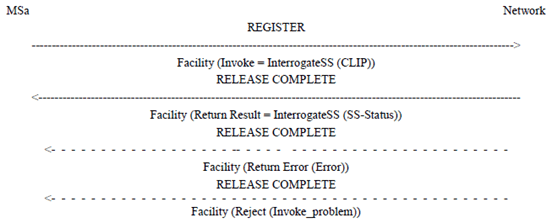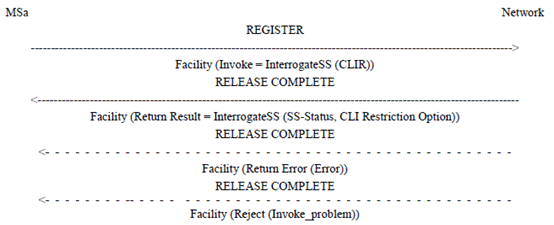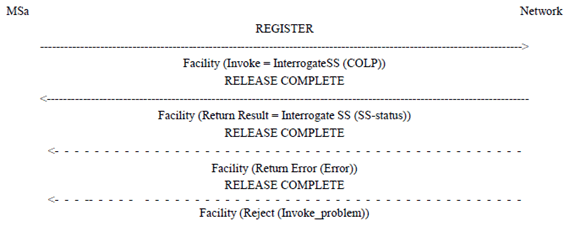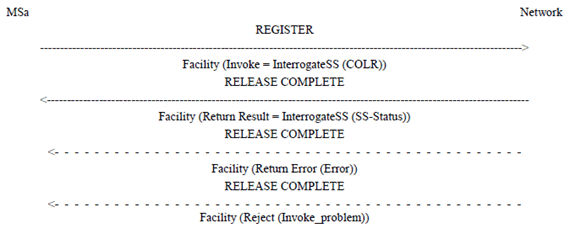TS 24.081
Line Identification
Supplementary Services
V18.0.0 (PDF)
2024/03 14 p.
V17.0.0
2022/03 14 p.
V16.0.0
2020/06 14 p.
V15.0.0
2018/06 14 p.
V14.0.0
2017/03 14 p.
V13.0.0
2015/12 14 p.
V12.0.0
2014/09 14 p.
V11.0.0
2012/09 14 p.
V10.0.0
2011/04 14 p.
V9.0.0
2009/12 14 p.
V8.0.0
2008/12 14 p.
V7.0.0
2007/07 14 p.
V6.0.0
2005/01 14 p.
V5.0.0
2002/06 14 p.
V4.0.1
2002/06 14 p.
V3.1.0
2000/06 14 p.
GSM Rel-98 v7.0.1
2000/01 13 p.
GSM Rel-97 v6.0.1
1998/11 13 p.
GSM Rel-96 v5.0.1
1996/11 17 p.
GSM Phase-2 v4.4.1
1994/11 16 p.
- Rapporteur:
- Mr. Wiehe, Ulrich
Nokia Solutions & Networks (S)
Content for TS 24.081 Word version: 18.0.0
0 Scope p. 5
The present document specifies the procedures used at the radio interface for normal operation, registration, erasure, activation, deactivation, invocation and interrogation of line identification supplementary services. Provision and withdrawal of supplementary services is an administrative matter between the mobile subscriber and the service provider and cause no signalling on the radio interface.
In TS 24.010 the general aspects of the specification of supplementary services at the layer 3 radio interface are given.
3GPP TS 24.080 specifies the formats and coding for the supplementary services.
Definitions and descriptions of supplementary services are given in TS 22.004 and 3GPP TS 22.08x and 3GPP TS 22.09x-series. TS 22.081 is related specially to line identification supplementary services.
Technical realization of supplementary services is described in TS 23.011 and 3GPP TS 23.08x and 3GPP TS 23.09x-series. TS 23.081 is related specially to line identification supplementary services.
The procedures for Call Control, Mobility Management and Radio Resource management at the layer 3 radio interface are defined in TS 24.007 and TS 24.008.
The following supplementary services belong to the line identification supplementary services and are described in the present document:
0.1 References p. 5
The following documents contain provisions which, through reference in this text, constitute provisions of the present document.
- References are either specific (identified by date of publication, edition number, version number, etc.) or non-specific.
- For a specific reference, subsequent revisions do not apply.
- For a non-specific reference, the latest version applies. In the case of a reference to a 3GPP document (including a GSM document), a non-specific reference implicitly refers to the latest version of that document in the same Release as the present document.
[1]
TR 21.905: "Vocabulary for 3GPP Specifications".
[2]
TS 22.081: "General on supplementary services".
[3]
TS 22.081: "Line identification supplementary services - Stage 1".
[4]
TS 22.082: "Call Forwarding (CF) supplementary services - Stage 1".
[5]
TS 22.083: "Call Waiting (CW) and Call Hold (HOLD) supplementary services - Stage 1".
[6]
TS 22.084: "MultiParty (MPTY) supplementary services - Stage 1".
[7]
TS 22.085: "Closed User Group (CUG) supplementary services - Stage 1".
[8]
TS 22.086: "Advice of Charge (AoC) supplementary services - Stage 1".
[9]
TS 22.088: "Call Barring (CB) supplementary services - Stage 1".
[10]
TS 22.090: "Unstructured Supplementary Service Data (USSD) - Stage 1".
[11]
TS 23.011: "Technical realization of supplementary services".
[12]
TS 23.081: "Line identification supplementary services - Stage 2".
[13]
TS 23.082: "Call Forwarding (CF) supplementary services - Stage 2".
[14]
TS 23.083: "Call Waiting (CW) and Call Hold (HOLD) supplementary services - Stage 2".
[15]
TS 23.084: "MultiParty (MPTY) supplementary services - Stage 2".
[16]
TS 23.085: "Closed User Group (CUG) supplementary services - Stage 2".
[17]
TS 23.086: "Advice of Charge (AoC) supplementary services - Stage 2".
[18]
TS 23.088: "Call Barring (CB) supplementary services - Stage 2".
[19]
TS 23.090: "Unstructured supplementary services operation - Stage 2".
[20]
TS 24.007: "Mobile radio interface signalling layer 3; General aspects".
[21]
TS 24.008: "Mobile radio interface layer 3 specification".
[22]
TS 24.010: "Mobile radio interface layer 3; Supplementary services specification; General aspects".
[23]
TS 24.080: "Mobile radio interface layer 3 supplementary services specification; Formats and coding".
0.2 Abbreviations p. 6
Abbreviations used in the present document are listed in TR 21.905.
1 Calling Line Identification Presentation (CLIP) p. 6
1.1 Normal operation p. 6
The calling line identity consists of a calling party BCD number and optionally, a calling party subaddress and/or a cause of no CLI.
The calling party BCD number information element is made up of a number of information units as indicated in TS 24.008.
In addition to or instead of the calling party's digits, the subscriber may be given the following information:
- screening indicator;
- presentation indicator.

Figure 1.1: Notification by the network to the called mobile subscriber
(⇒ copy of original 3GPP image)
(⇒ copy of original 3GPP image)
When the calling line identity is not available, the presentation indicator which is given to the called mobile subscriber takes the value of "number not available".
1.2 Interrogation p. 7
Status Check
The mobile subscriber can request the status of the supplementary service and be informed if the service is provided to him.

Figure 1.2: Interrogation of calling line identification presentation
(⇒ copy of original 3GPP image)
(⇒ copy of original 3GPP image)
1.3 Activation, deactivation, registration and erasure p. 7
Activation, deactivation, registration and erasure of the supplementary service calling line identification presentation are not applicable.
2 Calling Line Identification Restriction (CLIR) p. 7
2.1 Normal Operation p. 7
When calling line identification restriction is applicable, the originating network provides the destination network with a notification that the calling party's ISDN number, with possible additional address information, is not allowed to be presented to the called party.
If the called mobile user subscribes to calling line identification presentation and the calling party has calling line identification restriction applied, the called mobile party shall receive the presentation indicator showing "presentation restricted" in the calling party BCD field of the SETUP message, see Figure 1.1. In this case, the calling party's number (digits) will not be sent towards the called subscriber.
2.2 Requesting presentation of CLI p. 8
When the CLIR presentation mode is temporary (presentation restricted), it is possible for the subscriber to present his CLI on a per call basis. The MS shall send a CLIR suppression information element to the network.
If the subscriber tries to override CLIR (i.e. requests that the CLI is displayed), when he has subscribed to permanent mode a NotifySS shall be sent to the MS in order to inform that the override has not been performed and the call set-up shall continue.

2.3 Requesting restriction of CLI presentation p. 8
When the CLIR presentation mode is temporary (presentation allowed), it is possible for the subscriber to restrict the CLI on a per call basis. The MS shall send a CLIR invocation information element to the network.
If the subscriber has not subscribed to CLIR and tries to invoke CLIR (i.e. requests that the CLI is not displayed), the SETUP shall be rejected. The MS and the network shall act in accordance with TS 24.008 network initiated call clearing procedure, see Figure 2.2.

2.4 Interrogation p. 8
Data request
The mobile subscriber can request the data of the supplementary service.
If the service is not provisioned the network shall sent a return result including the SS-Status parameter.
If the service is provisioned the network shall sent a return result including the SS-Status and the CLI Restriction Option parameters.

Figure 2.3: Interrogation of calling line identification restriction
(⇒ copy of original 3GPP image)
(⇒ copy of original 3GPP image)
2.5 Activation, deactivation, registration and erasure p. 9
Activation, deactivation, registration and erasure of the supplementary service calling line identification restriction are not applicable.
3 Connected Line Identification Presentation (COLP) p. 9
3.1 Normal operation p. 9
The connected line identity consists of a connected number and optionally, a connected subaddress.
The connected number is made up of a number of information units as indicated in TS 24.008.
In addition to or instead of the connected number digits, the subscriber may be given the following information:
- screening indicator;
- presentation indicator.

Figure 3.1: Notification by the network to the calling mobile subscriber
(⇒ copy of original 3GPP image)
(⇒ copy of original 3GPP image)
When the connected line identity is not available (due to interworking or presentation restrictions), appropriate indication information is given to the calling mobile subscriber.
3.2 Interrogation p. 10
Status Check
The mobile subscriber can request the status of the supplementary service and be informed if the service is provided to him.

Figure 3.2: Interrogation of connected line identification presentation
(⇒ copy of original 3GPP image)
(⇒ copy of original 3GPP image)
3.3 Activation, deactivation, registration and erasure p. 10
Activation, deactivation, registration and erasure of the supplementary service connected line identification presentation is not applicable.
4 Connected Line Identification Restriction (COLR) p. 10
4.1 Normal operation p. 10
When connected line identification restriction is applicable the destination network provides the originating network with a notification that the connected party's ISDN number, with possible additional address information, is not allowed to be presented to the calling party.
If the calling mobile user subscribes to connected line identification presentation and the connected party has connected line identification restriction applied, the calling mobile party shall receive the presentation indicator showing "presentation restricted", see Figure 3.1. In this case, the connected number will not be sent towards the calling subscriber.
4.2 Interrogation p. 11
Status Check
The mobile subscriber can request the status of the supplementary service and be informed if the service is provided to him.

Figure 4.1: Interrogation of connected line identification restriction
(⇒ copy of original 3GPP image)
(⇒ copy of original 3GPP image)
4.3 Activation, deactivation, registration and erasure p. 11
Activation, deactivation, registration and erasure of the supplementary service connected line identification restriction are not applicable.